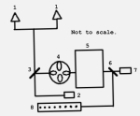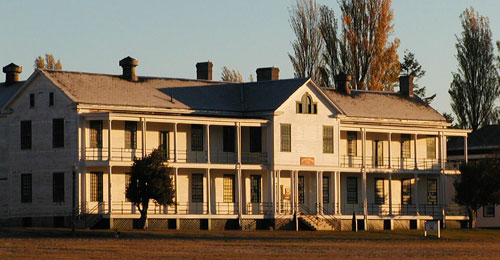At the beginning of WWII there was considerable concern about the number of casualties caused by gas attacks in WWI. Because of that, during WWII critical facilities were provided with gas filtering capabilities so that they could function and survive in case of a gas attack. They apparently weren't called 'filters' though, based on the labels and the building diagrams we have they were referred to as 'gas collectors' and mounted in 'collector rooms'. Two structures on Artillery Hill were modified to provide protection from poison gas attacks, and two new structures had gas protection designed in. At the time these were designed and built it's likely that no one involved knew about the radiation dangers from the then 'Top Secret' atomic bomb program, but it turned out that the filtering used for gas would also work for radioactive fallout. Because these types of structures were also designed to be protected from shell fire, the radiation protection was even better; the collectors would remove any radioactive fallout/dust, they all had thick (1.5 to 5 feet) concrete walls and ceilings and they all had earth at least over them, and in all but one case around the walls as well. This was probably enough to block any radiation from coming in through the walls or ceilings. One built into a hill side has a 5 foot thick concrete ceiling covered with 25 feet of dirt, and dirt on all sides, with only a tunnel access.

The basic principles of the gas protection systems in all 4 were very similar, but the details varied. Click the image at right for a representative diagram showing the basic design with some notes. It's also available as a PDF file. One critical requirement is that the building maintain 'positive pressure' where the air pressure inside is higher than it is outside, that way any leaks would let clean air out rather than potentially contaminated air in. While the pressure difference didn't need to be very much, it did require that there be an airlock that would allow personnel going in and out to equalize the pressure without depressurizing the entire facility. All of the structures had pressure relief vents with a one way flapper valve on them, usually in the airlock. These valves worked the same way as dryer vent pipes today, where the air pressure would simply lift the valve plate and let air blow by, the difference is that these flappers are steel instead of the plastic or light sheet metal on dryer vents, meaning it needed more pressure to open them. The weight of the flapper valve determined the pressure difference. All of the systems had a way to bypass the air filter allowing fresh air to be blown in the facility without using the filter when it wasn't needed.
The airlock was also the logical place to put the decontamination system since anyone coming in would need to be cleaned off before entering the main portion of the facility. The decontamination system consisted of a vertical 6 inch cast iron pipe with some fittings. Small holes were drilled in the pipe and the fittings which would allow pressurized air to blow on someone standing in front of it. An air intake pipe would suck up the contaminated air and return it to the collectors to be filtered again. Since poison gas/powder is heavier than air the intakes were usually very near the floor. Theoretically this would blow the contaminates off of the person and their clothing/equipment, then suck the contaminates back to the filter instead of letting them swirl around in the airlock. This probably worked OK in dry weather, but if the person coming in had been out in the rain (which happens a lot around here) the contaminates may have stuck to their clothing and other steps would probably be necessary. All the airlocks had a switch that turned on a blower if needed and operated two valves on the air lines. One valve would shut off the normal intake lines bringing in fresh air from the outside and cause the pumps to suck in air from the intake in the airlock, the other would shut off filtered air to the facility and cause it all to blow into the airlock, through the decon system. Since all the air that would normally go into the full structure was blowing through the small airlock, it was probably fairly well pressurized with a high rate of flow.
All four facilities had piping to bring outside air to the filters and then into the facility. Two (the HECP and the temporary HDCP) had hot water boilers connected to heat exchangers incorporated in the air circulation system, the GPMTCP had steam radiators with the boiler outside the protected area and pipes that circulated the hot water without bringing in contaminates, By using closed loop hot water systems the heater could be outside the gas protected area since it didn't matter if the combustion air was contaminated. If the heaters had been inside the protected area a lot more filtered air would have been required for the burners. Tolles had fireplaces which would have had to be closed off in case of a gas attack. None of the four had any actual windows although the GPMTCP had an upper observation booth with slit windows, the HDCP had two ceiling vents and two vents into outside underground rooms and Tolles had some holes drilled through the thick concrete walls to allow air flow for the fireplaces. All the openings were fitted with "gas tight" closures that would seal them off in case of a gas attack. In structures with ceiling vents, they also had valves that could be closed.
Click the bold name of each structure to see some photos related to the air filtration system.
The two modified structures were:
The center traverse at Battery Tolles (19 photos), which was a control post for some operations at the Fort during WWII. This had a two filter system installed to protect two rooms. The decontamination area was just inside the entry in a hallway that connected the two rooms, one to either side. The smaller room on the right had one air line, the larger room on the left had two. Both rooms had newly installed fireplaces and holes drilled in the thick concrete walls that could provide some light and fresh air when the blowers weren't being used. Unlike the other three facilities, the air filter was totally outside the protected area, accessing it required going outside and around the traverse to the filter room. A wooden partition had been constructed in what used to be a pass through, creating the airlock/entry on one side and a separate room for the filter on the other side. The other thing unique to Tolles was that it did not have a heating system that could operate while the collectors were in use since the fireplaces would have probably drawn too much air for a single filter to keep up with, meaning that there would be no heat during a gas attack.
The temporary Harbor Defense Command Post (HDCP), (30 photos) was used while the two new structures were built. This underground building was originally completed in 1901 and handed over to the army on June 16, 1902 as the plotting rooms for the 4 mortar pits. Later the Battery was split into 2 batteries of 2 mortar pits, each with it's own plotting room built at the back of the hills between the pits. Sometime after that the underground rooms were designated as the
War Chest
with no explanation. It's believed that they were used to store the fuses for the mortar shells.In 1943 it was remodeled to serve as the temporary HDCP. It had two filters installed in an airlock created by putting two wooden walls with sealed doors in the entry hallway. The back side of the airlock was almost 60 feet back into the hill. The airlock protected the rest of the hall, a latrine, and two rooms on either side of the hall. The entire structure is in a hill, covered by over 20 feet of dirt above the 5 foot thick concrete ceiling. The two rooms on the left and the latrine have 12 inch ceiling vents to draw air out, all three are marked as "gastight". There are two steel "windows" in the rooms on the right side that are marked "made gastight". They can be opened to provide a little air but one opens into a shell storage tunnel, the other into a small windowless room with one door so without the blowers air circulation is minimal. The heater was a coal fired boiler in the entry hallway, just inside the door but outside the airlock. The boiler heated water that was piped to the heat exchanger in the airlock, with the cooler water then piped back to the heater in a closed loop that would prevent any contaminates from being released inside the HDCP.
Like the other gasproofed structures the decontamination system was just inside the airlock, but the one in the HDCP was unique on the Fort because its return air intake was over 5 feet above the floor. In the other three structures the intake was within a couple of inches of the floor.
The two new structures were:
The Groupment Command Post/Gun Group Command Post (30 photos) between Batteries Benson and Ash was completed in July of 1943. It probably had a single air filter, we don't have detailed plans for it, that section of the piping is missing, and there is no trace of any mounts on the floor to provide clues. Only the Groupment Command Post side of the structure was gas proof. The decontamination area was in an airlock off the hallway at the top of the stairs. There are no windows in the Command Post itself, but there were slit windows in the connected Observation Booth. With those open there was probably enough air flow to get by. The boiler in a room at the top of the stairs provided hot water for radiators on both sides of the building so heat was available without running the filters or blowers. A bypass allowed the blowers to run without using the filters.
The Harbor Entrance Control Post/Harbor Defense Command Post (photos coming soon) was completed in December 1943 and jointly occupied by the Army and Navy. It was by far the largest and most sophisticated of the 4 gas protected structures. It had 3 filters in an internal room, with complex ducting bringing in outside air and distributing filtered air throughout the building. An oil fired boiler in one entrance hall (outside the gas protection) heated water that was pumped to a large heat exchanger that connected to duct work running throughout the entire building. A bypass system allowed the air circulation system to be used without running the air through the filters, it could also run without the heater in case that failed or wasn't needed. It probably took a long time to heat the building up, but after that because of the thick walls and ceiling and the earth around the whole building it probably stayed warm from the heat put out by the electronics. Without heat the whole structure is a constant 58 degrees (F) all year round. There were two decontamination rooms/air locks, one at each end of the building in the entry tunnels. One of the entrances also had a stairwell outside the airlock, that went up to an observation deck at surface level. There are no windows and only the two entrances at the end of tunnels. Fully manned and with all the equipment operating, without the air blowers working it probably would have become uncomfortable pretty quickly.

